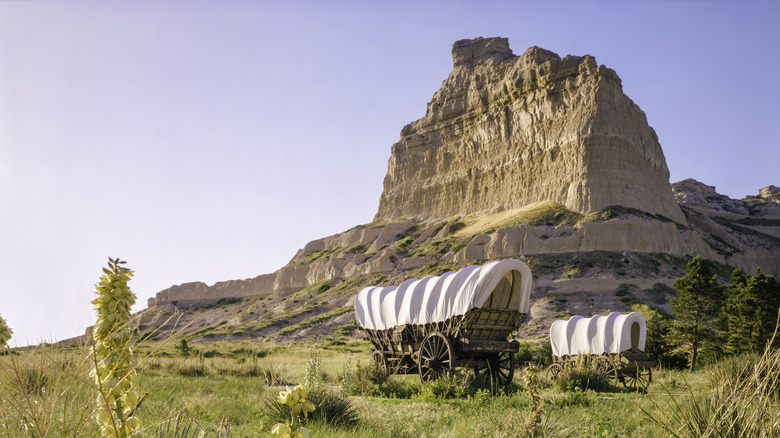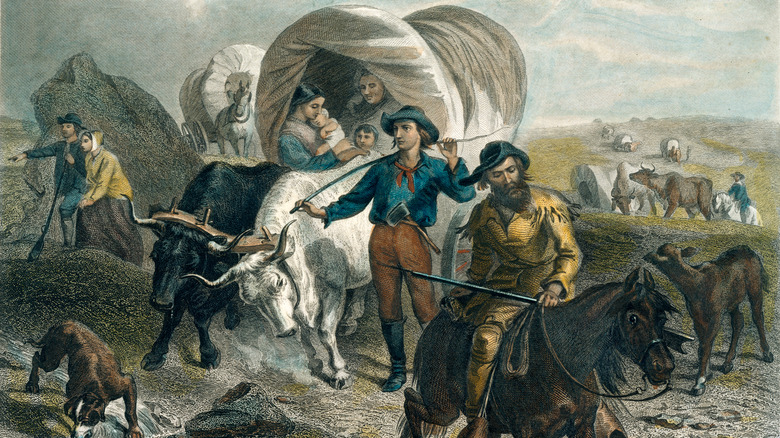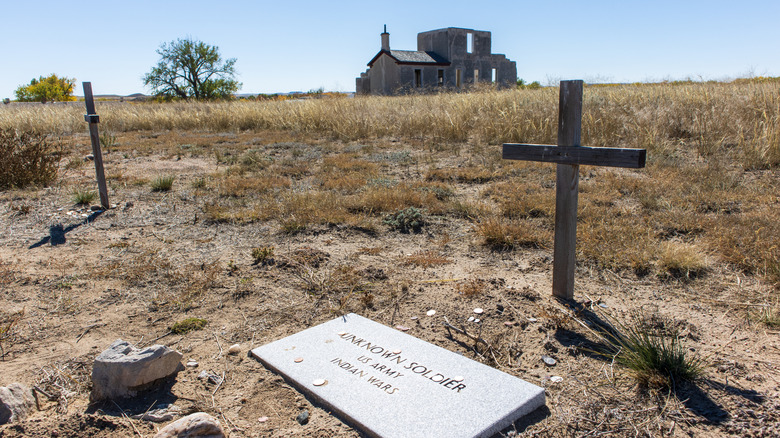The Gross And Most Common Reason So Many People Died On The Oregon Trail
The Oregon Trail sure was a swell 'ole time, wasn't it? Caravans of hardy pioneers trundling their way westward in wooden-wheeled wagons across a vast expanse of shrubs, sedge, and sand? Check. A 2000-mile-long stretch of nothin' but land, freedom, and the freedom to roll over that land? Check. Bad weather, bad food, an absolute lack of clean water, or even the most bare-bones hygiene? Check. Onslaughts of typhoid fever, tuberculosis, measles, mumps, dysentery, and other diseases? Check. Okay, maybe it wasn't so great, especially with the one killer above all others: cholera.
Cholera is the kind of disease that will make you glad to be alive now and not, say, in a wagon on the Oregon Trail from 1841 to 1869. Back then, about 350,000 people set out into the American West dying at a rate of about 10 to 15 per mile, per Legends of America. Total deaths are estimated from 20,000 to 30,000. Those who didn't die from anything we mentioned above might have died from a stampede of livestock, an accidentally discharged firearm, or collapsed from exhaustion and gotten run over by wagon wheels — whoops.
But cholera? Well, it's bad. It starts with vomiting and moves into dehydration, cramps, hypovolemic shock when the body can't pump blood, and if you make it through that: a diarrheic deluge. As Mayo Clinic very grotesquely describes, the diarrhea is "pale, milky," and looks like "water in which rice has been rinsed." Thanks for that. Victims continue diarrhea-ing about one liter per hour until it's all over.
Cholera spread via contaminated water
Cholera is a horrific disease that gets contracted from contaminated water. And when we say "contaminated," please forego any notions you have of icky non-filtered tap water that leaves a bit of lime deposit on the rim of the tap. "Contaminated" in this case means that it has bacteria in it from poop. Remember what we said about no clean water and bad sanitation on the Oregon Trail? Here's how it might have gone: Person A poops in some water, and then Person B ingests some of that water. That's it in a nutshell. And if loads of people everywhere have cholera and are stricken with diarrhea, it's really going to increase the chances of drinking poop water, accidentally or otherwise.
As Literacy Central explains, folks on the trail used whatever water they could find, like that in streams, ponds, rivers, and so forth. There was no guarantee of coming across any water sources while wandering through a vast expanse of unknown grasslands and deserts, so desperate settlers had to make do with whatever they found. Settlers unwittingly made the situation worse by digging holes to relieve themselves, and then having rain flush (so to speak) waste material into water used for drinking. Folks then drank that water or used it for cooking. Plus, there wasn't a lot of hand-washing with antibacterial soap going on, or other modern disease prevention methods.
Death by diarrhea
Even though we're focusing mostly on diarrhea because it's the most severe indicator of cholera, cholera takes victims through a whole torrent of terrible symptoms. Firstly, as Mayo Clinic points out, a person might be infected with cholera bacteria before presenting symptoms. During this time the bacteria can be passed along for a period of seven to 14 days. When symptoms do appear vomiting comes first and persists for hours. This dehydrates a person, which carries its own set of symptoms like fatigue, shriveled skin, emotional volatility, low blood pressure, shock, cramps, etc. Diarrhea comes last and can cause death within hours.
The good news is that cholera can't be spread from person to person — except for the whole poop thing. The other good news is that cholera is easy to treat nowadays. All it takes is a simple IV drip – provided you live in the kind of place where such things are readily accessible. This means that cholera wasn't only a horrid disease back in the mid-1800s, but still is. There were over 52,000 cases of cholera reported in April 2024 alone, per the European Center for Disease Prevention and Control. Many of these cases are linked to developing countries like Haiti, India, Ethiopia, Zambia, and more. Most cases came from Syria followed by Afghanistan. As the Journal of Tropic Medicine and Diseases reports, over 3 million people died from cholera from 1990 to 2019. Cholera actually claimed more lives in 2019 than 1990.


